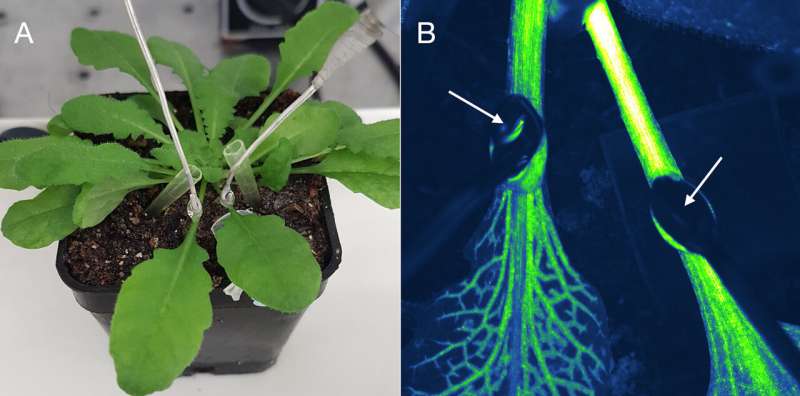Researchers discover how plants can respond to threats

Plants are constantly exposed to adverse environmental influences and attacks, for example from pest infestation. An international team of researchers led by Heinrich Heine University Düsseldorf (HHU) has now described a central part of the signal mechanism used by plants to respond to threats and thus initiate a defense response in unaffected parts of the plant. In the current edition of the journal Science Advances, they describe the role played by the protein MSL10, among others.
Changing weather conditions, alternating drought and rain, and pests such as plant-eating insects pose challenges for plants on a daily basis. Estimates suggest that between 5 and 20 percent of global harvests are lost to insect damage alone each year. Models indicate that this trend is likely to intensify as a result of global warming. From an economic and food safety perspective, this makes it important to know how plants respond to various threats and understand the defense strategies they have developed.
A consortium of researchers from Germany, Switzerland and the U.S. working with Professor Dr. Wolf B. Frommer from the Institute of Molecular Physiology at HHU has now discovered a central component used by plants to "notify" unwounded leaves when attacked. These leaves can then start to produce defense substances to protect adjacent tissue from the onslaught of such pests.
The research team focused on the plants' vascular system, which transports water and nutrients from the roots to the shoots of the plant. One of the ideas they wanted to examine was the age-old assumption that this vascular system also contributes to the dispersal of hydraulic, chemical and electrical signals and that hydraulic signaling is coupled with electrical signaling.
The continuous flow of water in parts of the vascular tissue creates a vacuum. When a plant is wounded, this flow of water is suddenly interrupted, resulting in pressure changes. The researchers have now identified a mechanosensitive ion channel called "MSL10," which registers the stretch of the cell membrane and the corresponding changes of pressure. When this pressure change coincides with a rise in glutamate—a substance that is liberated when a plant is wounded—the plant receives a rapid warning that it is under attack. In isolation, however, higher ambient glutamate levels can also be indicative of other metabolic fluctuations. Consequently, the change of pressure is significant when it occurs alongside an increase in glutamate levels. The researchers used surface electrodes positioned on wounded and unwounded leaves in order to measure this electrical signal in the form of characteristic voltage curves.
One key experiment involved blocking the formation of the MSL10 protein. Without MSL10, the electrical wound signal is shortened and signal molecules such as calcium ions disperse much less effectively. Plants without MSL10 also produce fewer defense molecules to combat natural enemies.
Dr. Thomas Kleist and Dr. Michael Wudick from HHU, who played a key role in the project, explained, "Our international team thus succeeded in demonstrating for the first time that a stretch-activated mechanosensitive ion channel is necessary for wound-induced signaling in plants."
The team also developed a model which demonstrates how MSL10 interacts with other proteins that also contribute to signaling. The research findings indicate clearly that the underlying assumption of a link between electrical and hydraulic signaling is correct.
Prof. Frommer had this to say on the far-reaching aspects of the findings just published in Science Advances: "It's fascinating to see that plants use electrical signals in the same way as animals and humans and that even the components involved are similar. If we can better understand wound signaling and the processes and components involved, we may be able to help plants recognize threats faster and defend themselves against them. This in turn could help prevent the loss of harvests due to pest infestation and insect damage."
More information: Interdependence of a mechanosensitive anion channel and glutamate receptors in distal wound signaling, Science Advances (2021). DOI: 10.1126/sciadv.abg4298
Journal information: Science Advances
Provided by Heinrich-Heine University Duesseldorf



















